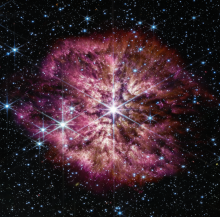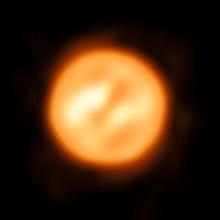Listen to today's episode of StarDate on the web the same day it airs in high-quality streaming audio without any extra ads or announcements. Choose a $8 one-month pass, or listen every day for a year for just $30.
You are here
Star in Transition?
A star in a nearby galaxy appears to be going through a rare transition — from a monster to a super-monster. If that’s the case, it could be setting up for another transition: blasting itself to bits as a supernova.
The star is in the galaxy M33, in the constellation Triangulum, which is in the east-northeast at nightfall.
M33 is less than three million light-years away — a next-door neighbor. The galaxy is a beautiful spiral. We see it at a bit of an angle, so it looks like an octopus twirling in a cosmic ballet. The galaxy is home to perhaps 40 billion stars, and it’s giving birth to many more.
Some of the new stars belong to class “O” — the biggest, brightest, and heaviest class. Such stars burn for only a few million years before they explode.
Some of those stars undergo a brief transition before they blow up. They become Wolf-Rayet stars. They’re the hottest and brightest stars of all, but they explode quickly. Before they explode, they blow huge amounts of gas into space — enough to make several stars as massive as the Sun in less than a million years.
The winds enwrap the star in clouds of gas and dust, and that’s one way astronomers identify them. A recent study identified several chemical elements around a monster star in M33. One of those elements has only recently become visible, suggesting that the star is undergoing rapid change — from a monster into a super-monster.
Script by Damond Benningfield





